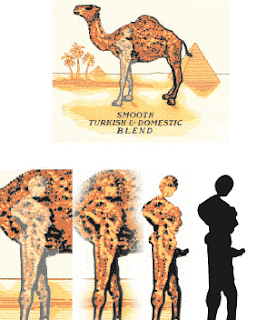 Even though western society has generally changed and is more open to the public expression of sexual freedom, there are still rules of taste for images to be viewed by the mainstream public. Fragonard's paintings show us that the French upper class in the late 18th century was frivolous and carefree, and they had a playful regard for sexuality and relationships. Today's ads show us that middle class North American society in the 20th century is all about consumerism and disposable income, and that pop culture has an open and easy perspective on sexuality. Ads in mainstream magazines use erotic symbolism as a useful tool to sell products. A person who owned a Fragonard painting in the 18th century, or CK underwear and Camels cigarettes in the 20th century, reveal that they share their respective society's views on sexuality. They believe that the producers of their chosen products are skilled professionals and can attest to the product's quality. Fragonard and advertisers use different symbols in different ways, and for different purposes, but the fact is that we continue to use them because western society still respects rules of modesty and taste, even we often try to break them.
Even though western society has generally changed and is more open to the public expression of sexual freedom, there are still rules of taste for images to be viewed by the mainstream public. Fragonard's paintings show us that the French upper class in the late 18th century was frivolous and carefree, and they had a playful regard for sexuality and relationships. Today's ads show us that middle class North American society in the 20th century is all about consumerism and disposable income, and that pop culture has an open and easy perspective on sexuality. Ads in mainstream magazines use erotic symbolism as a useful tool to sell products. A person who owned a Fragonard painting in the 18th century, or CK underwear and Camels cigarettes in the 20th century, reveal that they share their respective society's views on sexuality. They believe that the producers of their chosen products are skilled professionals and can attest to the product's quality. Fragonard and advertisers use different symbols in different ways, and for different purposes, but the fact is that we continue to use them because western society still respects rules of modesty and taste, even we often try to break them. Many Rococo artists, including Fragonard, used symbols in their work. New symbols were developed for art, revolving around love and mythology. Statues of Venus, Cupid, and Psyche represented different aspects of love and were usually painted in the background to mirror the actions and sentiments of couples in the foreground. Flower gardens are symbols of blossoming love, while a floral crown is a symbol of sexual consummation or commitment. A woman's shoeless foot or parted skirts mean that she is unchaste; the same thing may be said about a man without a hat. The presence of a cat represents promiscuity while the dog is a symbol of fidelity. The presence of a letter often indicates letters of love. All of these symbols can be found in Fragonard's work, and are used with great success. Some examples of Fragonard's symbolic paintings are “The progress of love” and “The swing” in 1766.
Many Rococo artists, including Fragonard, used symbols in their work. New symbols were developed for art, revolving around love and mythology. Statues of Venus, Cupid, and Psyche represented different aspects of love and were usually painted in the background to mirror the actions and sentiments of couples in the foreground. Flower gardens are symbols of blossoming love, while a floral crown is a symbol of sexual consummation or commitment. A woman's shoeless foot or parted skirts mean that she is unchaste; the same thing may be said about a man without a hat. The presence of a cat represents promiscuity while the dog is a symbol of fidelity. The presence of a letter often indicates letters of love. All of these symbols can be found in Fragonard's work, and are used with great success. Some examples of Fragonard's symbolic paintings are “The progress of love” and “The swing” in 1766.The couple in the painting appear to be having a secret affair, or are about to have one. This is indicated by the statue of Cupid holding a finger to his lips. The swing is a symbol of the fickle, playful woman. As the woman is swinging, her skirts part so that the man laying below is able to see up them. The man pushing the swing may be a bishop, or perhaps he is the woman's father or husband who is unaware of what is going on. The man holds out his hat and offers it to the woman as she loses her shoe, which suggests that they are both promiscuous. Her shoe flies through the air and will land in the bushes, where the couple will likely meet for a tryst.
 Many companies commonly use sexual symbols in advertising because the suggestion of sex helps them sell products; it fuels the fantasy of the sexy qualities that the product allegedly provides. The use of sexual symbols in 20th century advertising is very common and recognizable to most of those who see them. Skimpy and revealing clothing, lots of makeup, and overdone hair on a female model implies that she is sexually available. Men and women in intimate relationships in alcohol ads are depicted as having free and easy lifestyles, and this is especially true in their relationships. Cigarettes have become associated with sexual daring and sophistication. Romantic settings that include bedroom scenes with candles, exotic sheets and sleep wear, etc. implies a setting where sex is about to be initiated.
Many companies commonly use sexual symbols in advertising because the suggestion of sex helps them sell products; it fuels the fantasy of the sexy qualities that the product allegedly provides. The use of sexual symbols in 20th century advertising is very common and recognizable to most of those who see them. Skimpy and revealing clothing, lots of makeup, and overdone hair on a female model implies that she is sexually available. Men and women in intimate relationships in alcohol ads are depicted as having free and easy lifestyles, and this is especially true in their relationships. Cigarettes have become associated with sexual daring and sophistication. Romantic settings that include bedroom scenes with candles, exotic sheets and sleep wear, etc. implies a setting where sex is about to be initiated. 
No hay comentarios:
Publicar un comentario